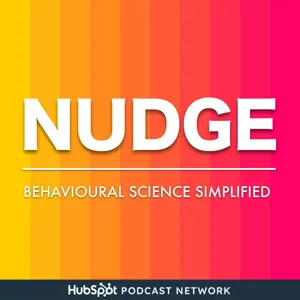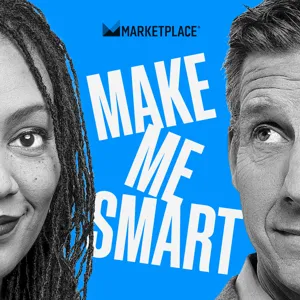Podcast Summary
Traditional marketing models may not accurately represent consumer behavior: Applying behavioral science and nudge theory can help marketers better understand consumer actions and improve business decisions.
Relying solely on traditional marketing models and market research for making business decisions may not yield accurate results. This was evident in the case of Trinity Mirror's failed attempt to launch a politically neutral, 30-minute read newspaper based on market research. Behavior scientist and Vice President of the BVA Nudge Unit, Richard Chataway, explains that models like AIDA are outdated and don't accurately explain how consumers act. Instead, modern marketers need to apply behavioral science and nudge theory to better understand consumer behavior. HubSpot's new service hub can help businesses provide personalized customer service, anticipate customer needs, and maintain happy customers at every stage of the journey. By combining service and success on one platform, businesses can scale support, drive retention, and increase revenue. Listen to the d two c pod for more insights on direct-to-consumer brands and check out Richard Chataway's book, The Behavior Business, for clear frameworks on applying behavioral science to marketing.
Marketing strategies not based on AIDA model's logic: Marketers should focus on understanding audience and behavioral drivers instead of relying solely on new ideas to create effective strategies.
The traditional AIDA model of human behavior and purchase decision making, which assumes a logical and rational process of awareness, interest, desire, and action, is not supported by modern behavioral science. People's purchase decisions are more instinctive and influenced by nonconscious factors than previously thought. Marketers need to understand these drivers of behavior to create effective marketing strategies. The AIDA model's inconsistent predictability and the industry's bias for novelty have led to frequent changes in marketing approaches. However, relying solely on new ideas can result in costly mistakes, as shown by Tropicana's failed rebranding attempt. Instead, marketers should focus on a deep understanding of their audience and the factors influencing their behavior.
Traditional marketing models may not accurately represent consumer behavior: Marketers should critically evaluate traditional marketing models and focus on reaching a large number of consumers frequently to build strong brands
Relying solely on traditional marketing models and methods to understand consumer behavior may not provide an accurate representation of the world. For instance, models like brand archetypes, which categorize consumers into 12 different types, can be misleading. By taking the average of multiple variables to build pen portraits of audiences, marketers risk targeting a fictional person. Furthermore, claims about consumers changing faster than ever due to technology may not always hold true, as the inertia bias shows that most people are resistant to change. Instead, marketers should consider the findings from Byron Sharp's book, "How Brands Grow," which emphasizes the importance of focusing on reaching a large number of consumers frequently to build strong brands. In a rapidly evolving marketing landscape, it's crucial to approach consumer understanding with a critical and nuanced perspective.
Targeting larger consumer base of 'light users' for brand growth: Focusing on larger consumer base of 'light users' who have a shorter list of criteria and are heavily influenced by heuristics can generate significant growth for brands, as most people are satisficers and make decisions based on good enough options.
Effective marketing for brand growth involves targeting a larger consumer base of "light users" rather than being excessively niche. These light users represent the largest group of potential consumers and require only a small incremental impact to generate significant growth. According to behavioral science, most people are satisficers, making decisions based on good enough options rather than maximizing every purchase. Targeting these consumers, who have a shorter list of criteria and are heavily influenced by heuristics, is more effective for marketers than focusing on a subset of the market. Using the example of Coca-Cola, it's clear that the majority of their buyers are light consumers, purchasing the product only a few times per year. Encouraging these consumers to buy just one more can per year would have a much greater impact on revenue than targeting heavy users who already purchase frequently. Therefore, broadening marketing efforts to target the largest possible market is more effective for brand growth.
The Role of Personal Value in B2B Decision-Making: Professional, social, emotional, and self-image benefits are twice as important as business value in B2B decision-making. Costly signaling, such as large format outdoor posters, can effectively communicate trustworthiness and help businesses stand out in the market.
Personal value plays a significant role in business-to-business (B2B) decision-making, even in multimillion-pound purchases. Research shows that professional, social, emotional, and self-image benefits are twice as important as business value. This idea that subtle marketing cues, or "nudges," can influence behavior is not limited to cheap consumer products like Coke. Richard's example of launching the banking brand ING in the UK illustrates this concept. ING Direct, an online and telephone-only bank, used large format outdoor posters to demonstrate permanence and security in a crowded marketplace. This strategy, which conveyed stability and trustworthiness, helped the brand achieve high share of voice and rapid customer growth. In essence, costly signaling – the idea that visible spending or status symbols communicate trustworthiness – played a crucial role in ING's successful launch. The physical nature of large outdoor posters, which subconsciously communicated permanence and stability, was a more cost-effective way to reach potential customers compared to TV advertising. This strategy not only helped ING stand out in the market but also resonated with customers, resulting in impressive business growth.
Effective marketing strategies involve costly signaling to build trust and appeal to better long-term customers: Utilize consumer behavior insights and effective messaging to create value, even with limited budgets.
Effective marketing strategies often involve costly signaling to build trust and appeal to better long-term customers. ING's success with out-of-home ads is an excellent example, as it communicated scale, permanence, and trustworthiness to consumers. However, not all businesses have the budget for such extensive advertising. KFC optimized their marketing message by using behavioral science techniques to find the most effective way to articulate a simple offer of chips for a dollar. The most compelling message was "chips for a dollar, limited to 4 per customer." This scarcity tactic leveraged loss aversion and scarcity bias, making the offer seem more valuable and desirable. Overall, understanding consumer behavior and utilizing effective messaging, regardless of budget size, is crucial for successful marketing campaigns.
Understanding Consumer Behavior through Observation: Market research alone may not fully capture consumer behavior. Observing consumer actions can provide valuable insights. Traditional marketing frameworks may not accurately reflect consumers. Targeting the largest market is more effective than a niche. Self-reported data can be skewed by human memory and tendencies to overclaim or underclaim.
Relying solely on consumer feedback through market research may not provide a complete understanding of consumer behavior. A study on KFC's marketing strategy highlights this, as customers would not have selected the most effective slogan (limiting options to 4 bags of chips) in market research. Instead, observing consumer behavior can provide valuable insights. Traditional marketing frameworks like AIDA and archetypes may not accurately reflect consumers. When launching a product, campaign, or rebrand, targeting the largest market is more effective than a niche. And for market research, it's crucial to observe behavior in addition to gathering self-reported data. Human memory and tendencies to overclaim or underclaim can skew results. Examples like Trinity Mirror's New Day, Tropicana's rebranding, and the National Survey of Sexual Attitudes and Lifestyles illustrate the importance of observing behavior over relying solely on self-reported data.
Applying Behavioral Science and Nudges for Successful Product Launches: Identify problems, design nudges, and test/refine for effective influence on people's behavior towards successful product launches. Get insights and practical tips from Richard's book on the subject.
Applying behavioral science and nudges within an organization can significantly improve the success rate of product launches. This was emphasized by Richard, a guest on the Nudge podcast, who shared his insights from his new and honest book on the subject. He suggested three steps: identifying the problem, designing the nudge, and testing and refining. By following these steps, organizations can effectively influence people's behavior towards achieving their goals. Richard's book, which is available for purchase in the show notes, provides valuable insights and practical tips for implementing these strategies. Listeners are encouraged to share their thoughts and experiences, as well as leave a review on Apple Podcasts and sign up for the mailing list for updates on new episodes.



